Synthesis of Tetrasubstituted Alkenes via Metathesis
Abstract
:1. Introduction



2. Results and Discussion
2.1. Early Studies with a Molybdenum Catalyst
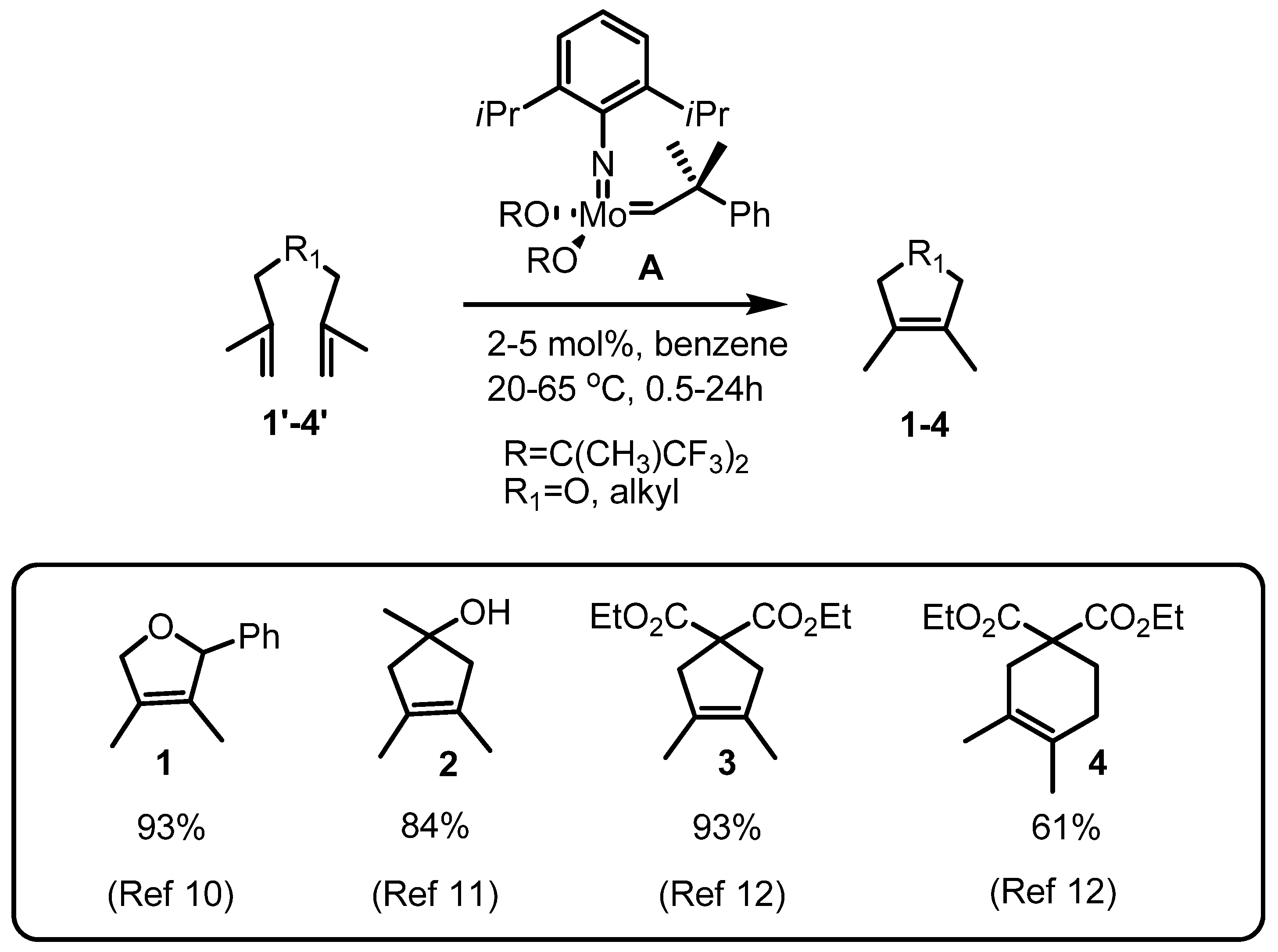
2.2. Early Studies with a Ruthenium Catalyst

2.3. New Catalyst Design and Its Application
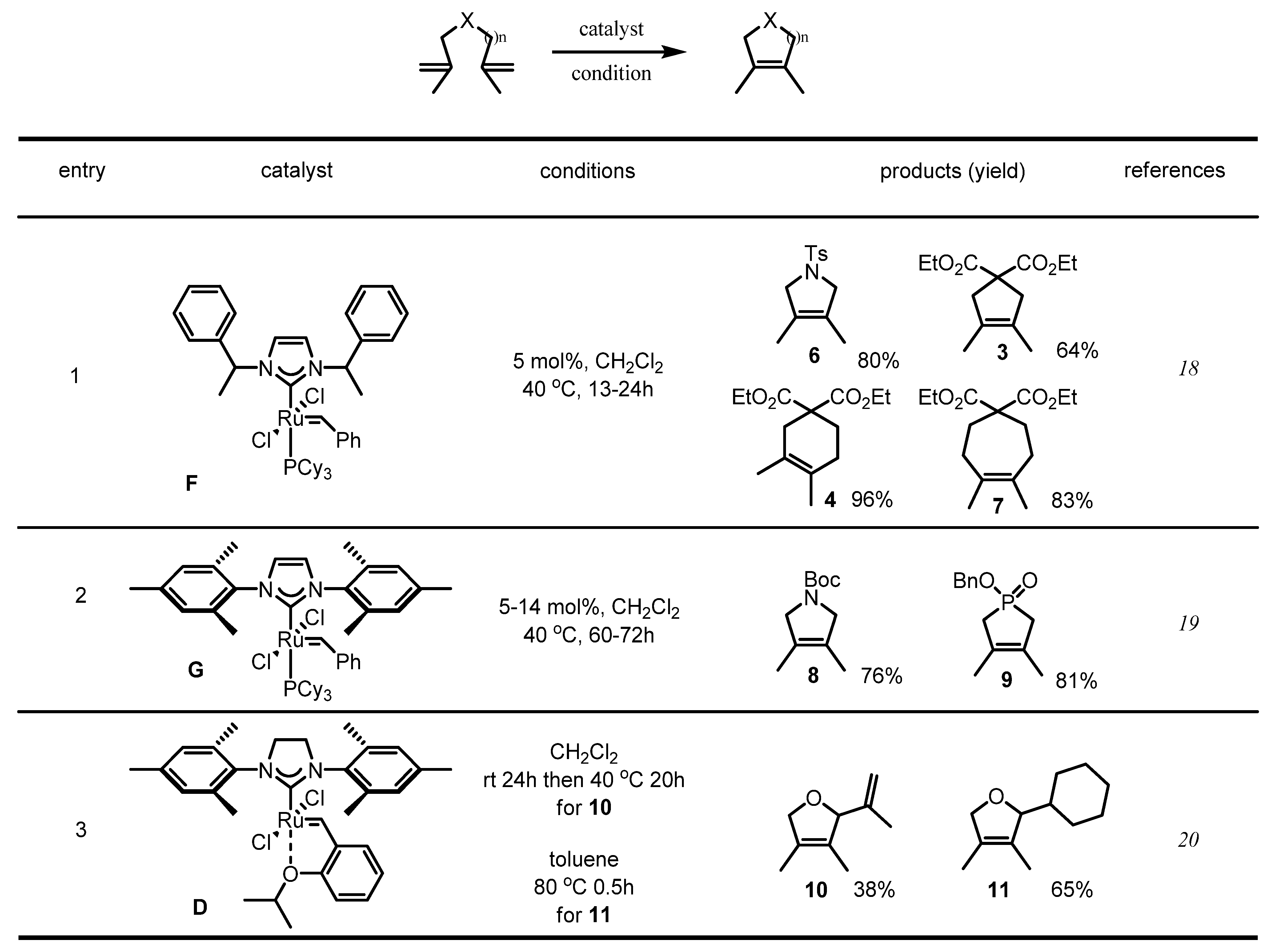
2.4. Optimization of Reaction Conditions

2.5. Further Catalyst Development
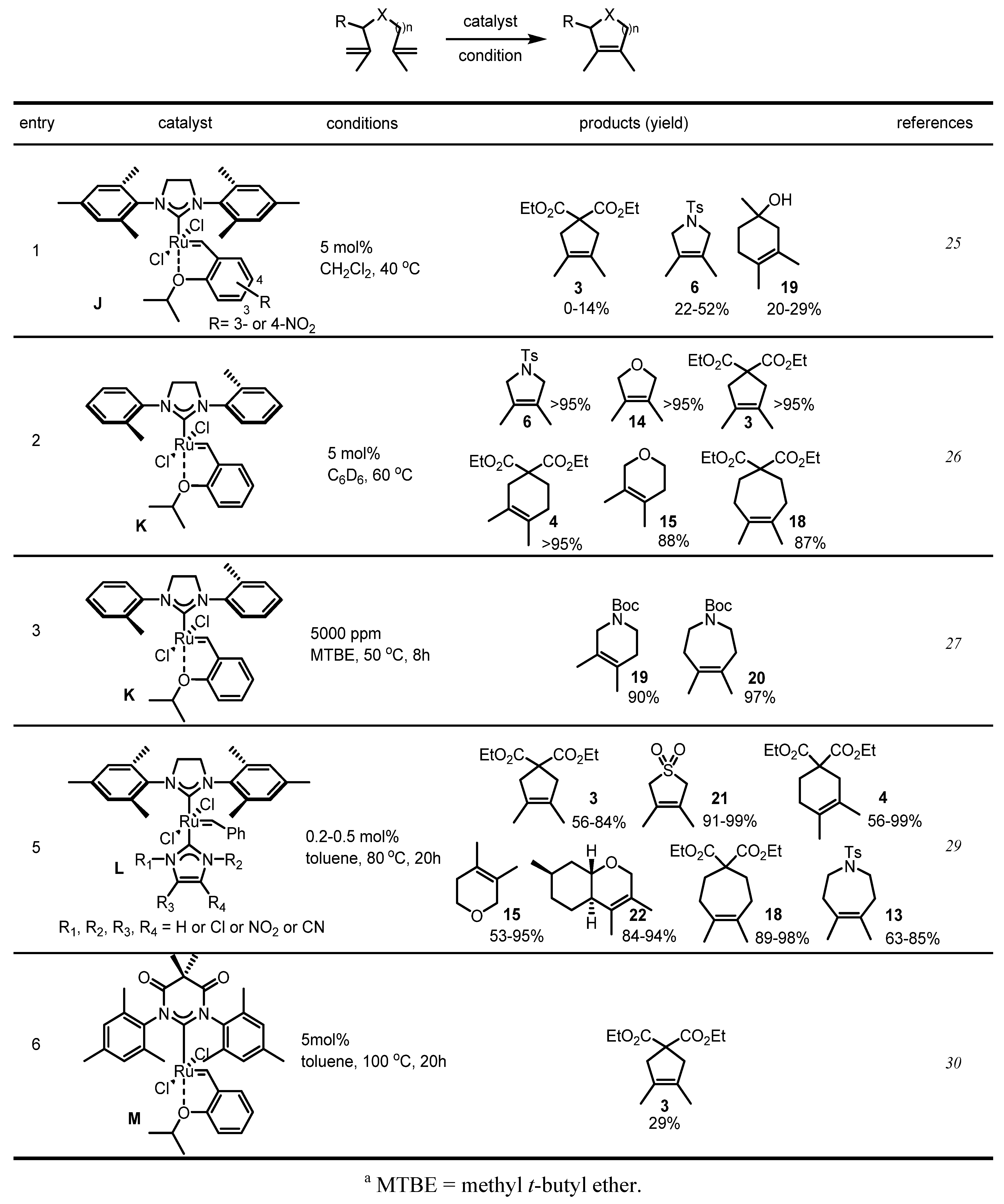
2.6. Asymmetric RCM in Tetrasubstituted Alkenes
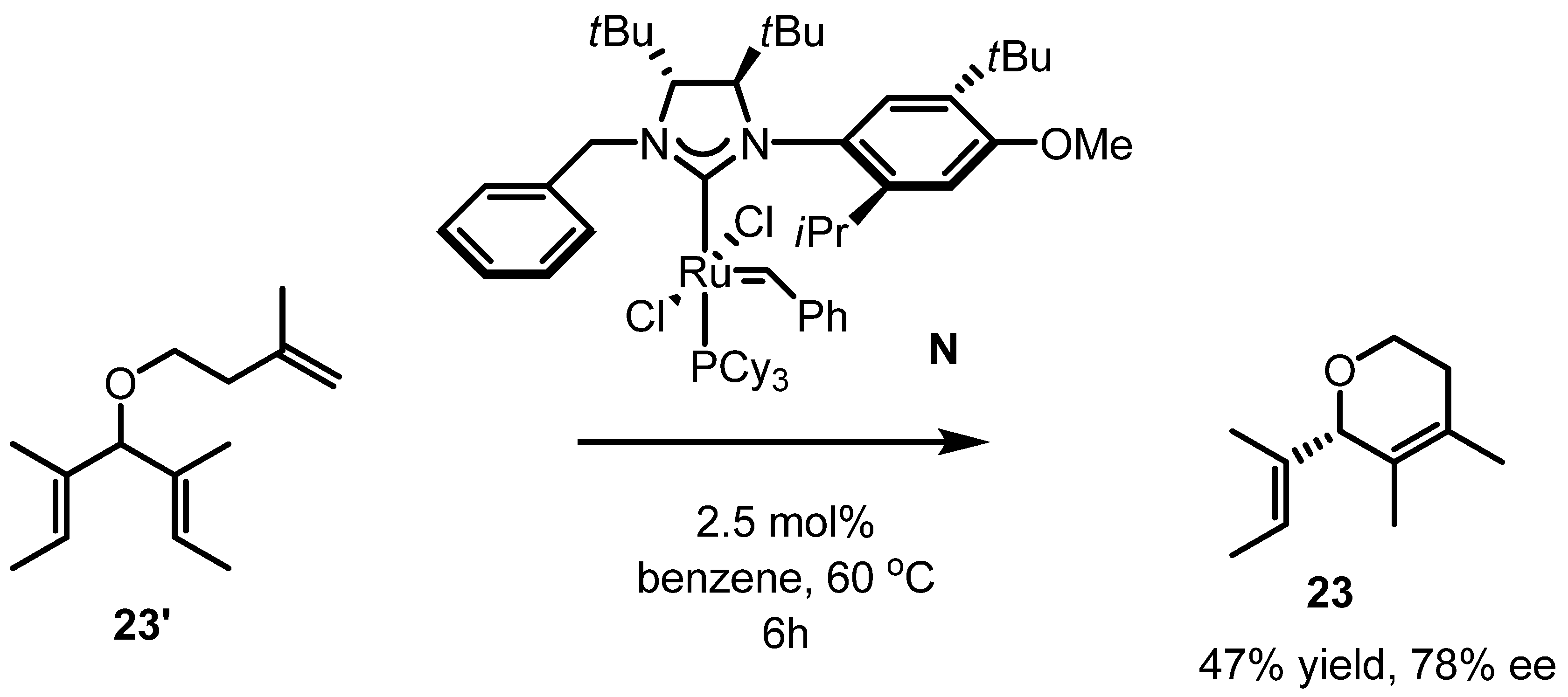
2.7. Cross Metathesis in Tetrasubstituted Alkenes
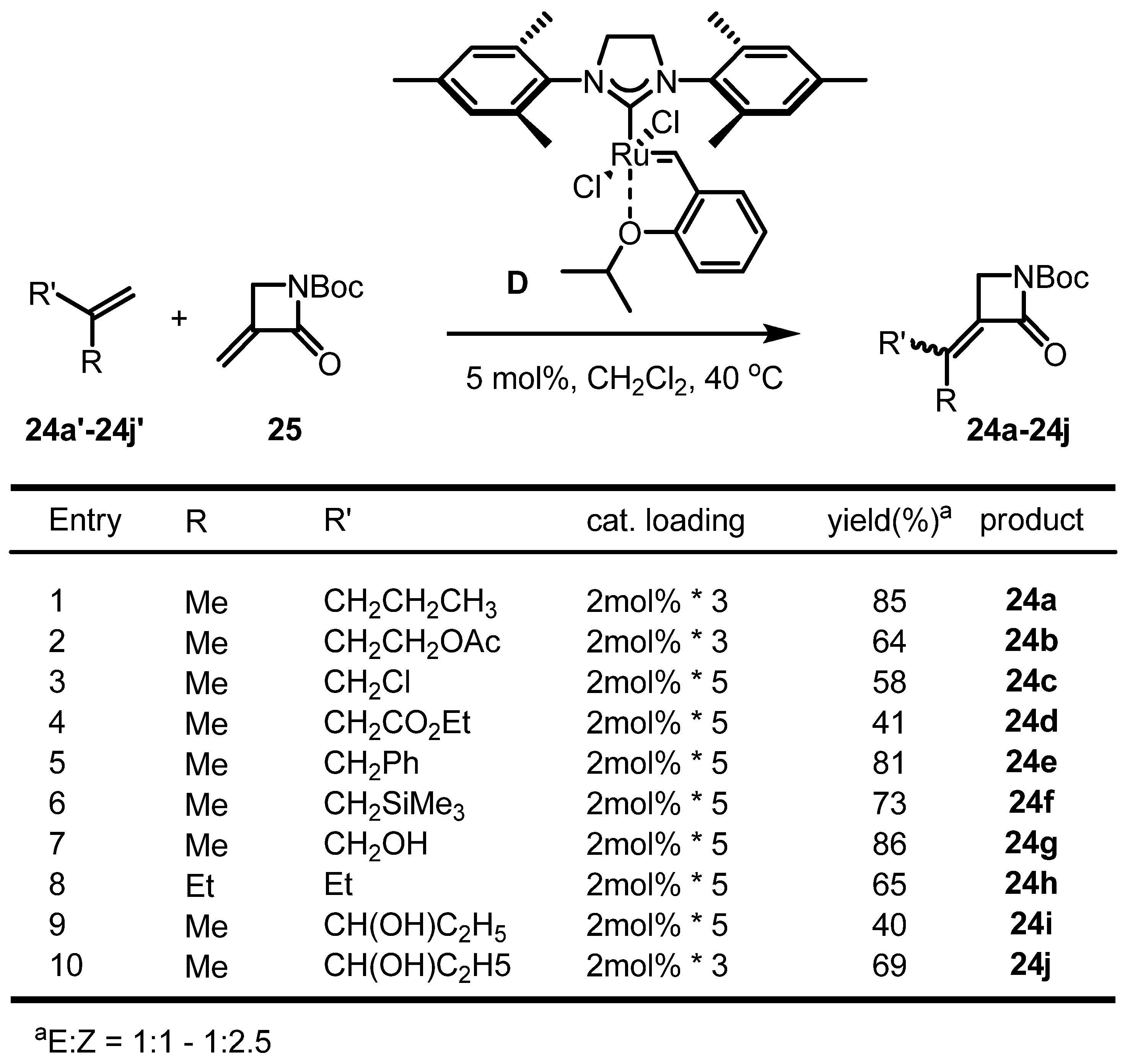
2.8. Application of Metathesis in Tetrasubstituted Alkenes
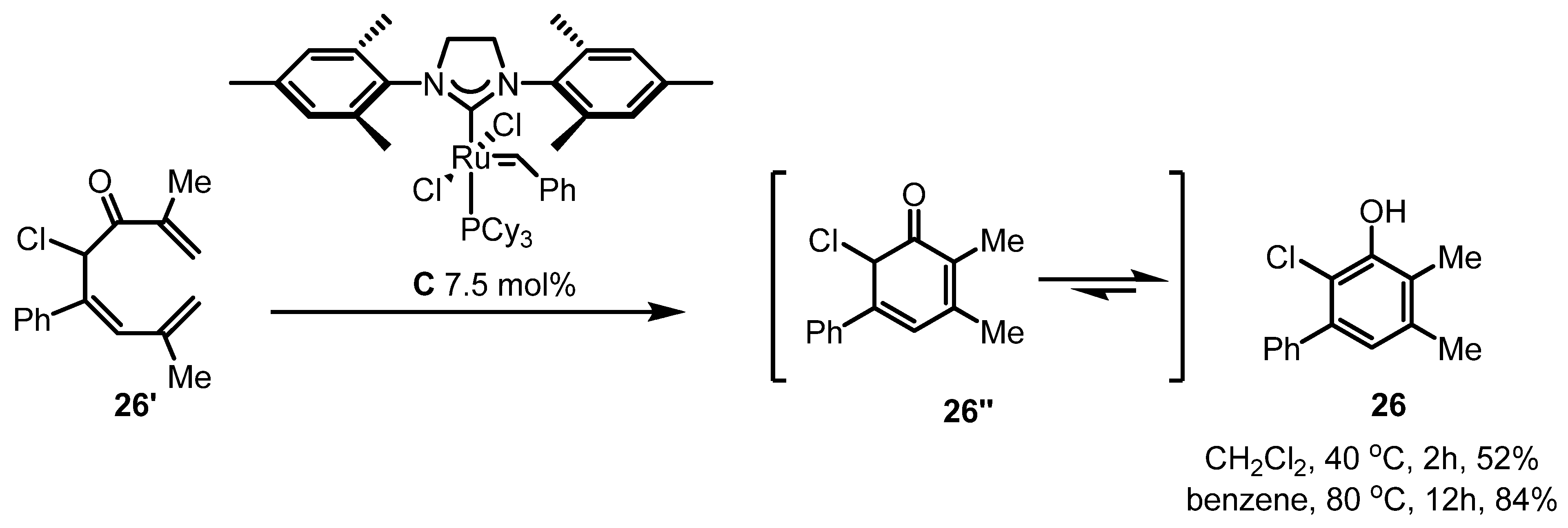

3. Conclusions
Acknowledgements
References
- Vougioukalakis, G.C.; Grubbs, R.H. Ruthenium-based heterocyclic carbene-coordinated olefin metathesis catalysts. Chem. Rev. 2010, 110, 1746–1787. [Google Scholar]
- Hoveyda, A.H.; Zhugralin, A.R. The remarkable metal-catalysed olefin metathesis reaction. Nature 2007, 450, 243–251. [Google Scholar] [CrossRef]
- Grubbs, R.H.; Miller, S.J.; Fu, G.C. Ring-closing metathesis and related processes in organic synthesis. Acc. Chem. Res. 1995, 28, 446–452. [Google Scholar] [CrossRef]
- Deiters, A.; Martin, S.F. Synthesis of oxygen- and nitrogen-containing heterocycles by ring-closing metathesis. Chem. Rev. 2004, 104, 2299–2238. [Google Scholar]
- Chauvin, Y. Olefin metathesis: The early days (Nobel Lecture). Angew. Chem. Int. Ed. Engl. 2006, 45, 3740–3747. [Google Scholar] [CrossRef]
- Schrock, R.R. Multiple metal-carbon bonds for catalytic metathesis reactions (Nobel Lecture). Angew. Chem. Int. Ed.Engl. 2006, 45, 3748–3759. [Google Scholar] [CrossRef]
- Grubbs, R.H. Olefin metathesis catalysts for the preparation of molecules and materials (Nobel Lecture). Angew. Chem. Int. Ed. Engl. 2006, 45, 3760–3765. [Google Scholar] [CrossRef]
- Meek, S.J.; O’Brien, R.V.; Llaveria, J.; Schrock, R.R.; Hoveyda, A.H. Catalytic Z-selective olefin cross-metathesis for natural product synthesis. Nature 2011, 471, 461–466. [Google Scholar] [CrossRef]
- Yu, M.; Wang, C.; Kyle, A.F.; Jakubec, P.; Dixon, D.J.; Schrock, R.R.; Hoveyda, A.H. Synthesis of macrocyclic natural products by catalyst-controlled stereoselective ring-closing metathesis. Nature 2011, 479, 88–93. [Google Scholar] [CrossRef]
- Rosen, E.L.; Sung, D.H.; Chen, Z.; Lynch, V.M.; Bielawski, C.W. Olefin metathesis catalysts containing acyclic diaminocarbenes. Organometallics 2010, 29, 250–256. [Google Scholar]
- Keitz, B.K.; Endo, K.; Herbert, M.B.; Grubbs, R.H. Z-selective homodimerization of terminal olefins with a ruthenium metathesis catalyst. J. Am. Chem. Soc. 2011, 133, 9686–9688. [Google Scholar]
- Keitz, B.K.; Fedorov, A.; Grubbs, R.H. Cis-selective ring-opening metathesis polymerization with ruthenium catalysts. J. Am. Chem. Soc. 2012, 134, 2040–2043. [Google Scholar]
- Fu, G.C.; Grubbs, R.H. The application of catalytic ring-closing olefin metathesis to the synthesis of unsaturated oxygen heterocycles. J. Am. Chem. Soc. 1992, 114, 5426–5427. [Google Scholar]
- Fu, G.C.; Grubbs, R.H. Synthesis of cycloalkenes via alkylidene-mediated olefin metathesis and carbonyl olefination. J. Am. Chem. Soc. 1993, 115, 3800–3801. [Google Scholar] [CrossRef]
- Kirkland, T.A.; Grubbs, R.H. Effects of olefin substitution on the ring-closing metathesis of dienes. J. Org. Chem. 1997, 62, 7310–7318. [Google Scholar] [CrossRef]
- Kim, S.H.; Zuercher, W.J.; Bowden, N.B.; Grubbs, R.H. Catalytic ring closing metathesis of dienynes: construction of fused bicyclic [n.m.0] rings. J. Org. Chem. 1996, 61, 1073–1081. [Google Scholar]
- Scholl, M.; Ding, S.; Lee, C.W.; Grubbs, R.H. Synthesis and activity of a new generation of ruthenium-based olefin metathesis catalysts coordinated with 1,3-dimesityl-4,5-dihydroimidazol-2-ylidene ligands. Org. Lett. 1999, 1, 953–956. [Google Scholar] [CrossRef]
- Ackermann, L.; Furstner, A.; Weskamp, T.; Kohl, F.J.; Herrmann, W.A. Ruthenium carbene complexes with imidazolin-2-ylidene ligands allow the formation of tetrasubstituted cycloalkenes by RCM. Tetrahedron Lett. 1999, 40, 4787–4790. [Google Scholar]
- Briot, A.; Bujard, M.; Gouverneur, V.; Nolan, S.P.; Mioskowski, C. Improvement in olefin metathesis using a new generation of ruthenium catalyst bearing an imidazolylidene ligand: Synthesis of heterocycles. Org. Lett. 2000, 2, 1517–1519. [Google Scholar] [CrossRef]
- Garber, S.B.; Kingsbury, J.S.; Gray, B.L.; Hoveyda, A.H. Efficient and recyclable monomeric and dendritic Ru-based metathesis catalysts. J. Am. Chem. Soc. 2000, 122, 8168–8179. [Google Scholar]
- Furstner, A.; Ackermann, L.; Beck, K.; Hori, H.; Koch, D.; Langemann, K.; Liebl, M.; Six, C.; Leitner, W. Olefin metathesis in supercritical carbon dioxide. J. Am. Chem. Soc. 2001, 123, 9000–9006. [Google Scholar]
- Marhold, M.; Buer, A.; Hiemstra, H.; van Maarseveen, J.H.; Haufe, G. Synthesis of vinyl fluorides by ring-closing metathesis. Tetrahedron Lett. 2004, 45, 57–60. [Google Scholar] [CrossRef]
- Yao, Q.; Zhang, Y. Poly(fluoroalkyl acrylate)-bound ruthenium carbene complex: A fluorous and recyclable catalyst for ring-closing olefin metathesis. J. Am. Chem. Soc. 2004, 126, 74–75. [Google Scholar]
- Rost, D.; Porta, M.; Gessler, S.; Blechert, S. A hexafluorobenzene promoted ring-closing metathesis to form tetrasubstituted olefins. Tetrahedron Lett. 2008, 49, 5968–5971. [Google Scholar]
- Michrowska, A.; Bujok, R.; Harutyunyan, S.; Sashuk, V.; Dolgonos, G.; Grela, K. Nitro-substituted Hoveyda-Grubbs ruthenium carbenes: Enhancement of catalyst activity through electronic activation. J. Am. Chem. Soc. 2004, 126, 9318–9325. [Google Scholar]
- Stewart, I.C.; Ung, T.; Pletnev, A.A.; Berlin, J.M.; Grubbs, R.H.; Schrodi, Y. Highly efficient ruthenium catalysts for the formation of tetrasubstituted olefins via ring-closing metathesis. Org. Lett. 2007, 9, 1589–1592. [Google Scholar] [CrossRef]
- Kuhn, K.M.; Champagne, T.M.; Hong, S.H.; Wei, W.H.; Nickel, A.; Lee, C.W.; Virgil, S.C.; Grubbs, R.H.; Pederson, R.L. Low catalyst loadings in olefin metathesis: Synthesis of nitrogen heterocycles by ring-closing metathesis. Org. Lett. 2010, 12, 984–987. [Google Scholar]
- White, D.E.; Stewart, I.C.; Grubbs, R.H.; Stoltz, B.M. The catalytic asymmetric total synthesis of elatol. J. Am. Chem. Soc. 2008, 130, 810–811. [Google Scholar] [CrossRef]
- Sashuk, V.; Peeck, L.H.; Plenio, H. [(NHC)(NHC)RuCl2(CHPh)] Complexes with modified NHC ligands for efficient ring-closing metathesis leading to tetrasubstituted olefins. Chem. Eur. J. 2010, 16, 3983–3993. [Google Scholar]
- Moerdyk, J.P.; Bielawski, C.W. Olefin metathesis catalysts containing N,N'-diamidocarbenes. Organometallics 2011, 30, 2278–2284. [Google Scholar] [CrossRef]
- Stenne, B.; Timperio, J.; Savoie, J.; Dudding, T.; Collins, S.K. Desymmetrizations forming tetrasubstituted olefins using enantioselective olefin metathesis. Org. Lett. 2010, 12, 2032–2035. [Google Scholar] [CrossRef]
- Liang, Y.; Raju, R.; Le, T.; Taylor, C.D.; Howell, A.R. Cross-metathesis of α-methylene-β-lactams: the first tetrasubstituted alkenes by CM. Tetrahedron Lett. 2009, 50, 1020–1022. [Google Scholar] [CrossRef]
- Yoshida, K.; Imamoto, T. A new synthetic approach to phenol derivatives: Use of ring-closing olefin metathesis. J. Am. Chem. Soc. 2005, 127, 10470–10471. [Google Scholar] [CrossRef]
© 2012 by the authors; licensee MDPI, Basel, Switzerland. This article is an open-access article distributed under the terms and conditions of the Creative Commons Attribution license (http://creativecommons.org/licenses/by/3.0/).
Share and Cite
Paek, S.-M. Synthesis of Tetrasubstituted Alkenes via Metathesis. Molecules 2012, 17, 3348-3358. https://doi.org/10.3390/molecules17033348
Paek S-M. Synthesis of Tetrasubstituted Alkenes via Metathesis. Molecules. 2012; 17(3):3348-3358. https://doi.org/10.3390/molecules17033348
Chicago/Turabian StylePaek, Seung-Mann. 2012. "Synthesis of Tetrasubstituted Alkenes via Metathesis" Molecules 17, no. 3: 3348-3358. https://doi.org/10.3390/molecules17033348



